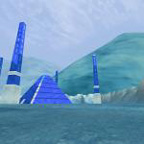June 20, 2007
[iDC] game culture (?) (!) (%#@)
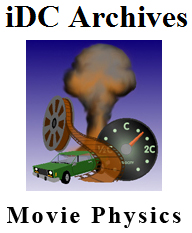
Game Physics
[...] I am at the beginning of some research into the area of game physics (that is, the simulation of physics in video games) ... The research is somewhat motivated by several observations:
Physics has an interesting split personality in that it is viewed as very fundamental in the sciences with a lot of 'prestige' (Einstein is a folk-hero), but at the same time Physics seems to be largely rejected as a discussion topic by non-science educated folks. As soon as it gets a bit more detailed and mathematical, most people will react try to avoid Physics. The current state of physics education (low number of graduates, etc.) confirms this.
Games on the other hand are well on the way (if not already there) to become the most used, most influential, most profitable entertainment medium. Therefore one can safely assume that they exert a significant influence on our culture. This trend which will continue in the years to come, especially as graphics capabilities reach photorealistic levels.
Game Physics is an element in video games that was always present and is even at the root of games (SpaceWar, the first video game was a physics simulation). It is becoming even more common due to the 3D and immersive nature of todays video games, because it makes games 'playable'. Generally it is a very important aspect of games since it is directly linked to the interactivity and 'feel' of the gameworld, but as a topic of game theoretical analysis, it is often overlooked.
As for some specific questions, I am currently interested in a discussion on how games affect the relationship we have with the real world. Obviously there are social implications to video game play as we can see from the whole "violence in games" debate. In relationship to Physics, I am looking at more fundamental changes in how we construct truths: Does video game physics create a form of "folk physics" (my immediate answer would be yes) and does that change the way we think or even act? For readers unfamiliar with video games, think of the 'Movie Physics' - which todays games largely adopt - such as the engine roar of a space ship flying by the camera (... this should be silent in vacuum).
So in some sense, the question extends the common "does it matter that movies have pseudo physics?" discussed extensively on site like http://www.intuitor.com/moviephysics/ to "does it matter when video games have pseudo physics?" (and believe me they do!). Why don't game developers try harder and game players expect more?
If one looks critically at mass media today, are we not creating a whole new "church of entertainment" especially with video games, where - at least as far as physical simulations are concerned - the scientific method and precision becomes irrelevant or at best secondary over the goal of implementing the next, better implementation of a game as 'VR drug' or 'consentual hallucinations' as W. Gibson puts it?
Could the trend we see in the popularity for 'documentaries' - especially ones with a scientific slant such as 'An Inconvenient Truth' be extended to mainstream video games? Personally I feel sad to see that Physics is typically reduced to animating ragdoll-enemies, chaingun-bullets and flamethrower-particles ... so why not extend game physics to include more quantum-mechanics? Maybe this would allow us to bridge the gap between game-cultures and science-cultures.
--AS
Corrado Morgana wrote:
Andreas,
I think you may be misinterpreting the notion of physics within games...it is not to demonstrate science, but physics as in physicality..objects have weight, mass and motion similar to real life objects and are used as ludic elements..that which foster gameplay..check out Half life 2 et al and much indie gaming which, for a while seemed to be obsessed with physics based gaming..it is simulation within set parameters
Folk physics..yup agreed, but you have to consider the role of games, Freelancer is a damn sight more fun than Orbiter, a very realistic, space flight simulator
There are few games which address scientific issues, OK Prey and the soon to be released Portal may look at disjointed physicality (that word again)..but talking about games and quantum mechanics may be more about pedagogic simulation; difficult game premise
However there may be an answer..
Check out Garry's mod for Half life 2...a physics based sandpit that could ideally be used, I think in your terms
Corrado Morgana...games researcher
iDC -- mailing list of the Institute for Distributed Creativity iDC[at]mailman.thing.net http://mailman.thing.net/cgi-bin/mailman/listinfo/idc
List Archive:
http://mailman.thing.net/pipermail/idc/
iDC Photo Stream:
http://www.flickr.com/photos/tags/idcnetwork/
Posted by jo at 12:29 PM | Comments (0)
June 01, 2007
Alternate Reality Games or Fiction of the Future?

The Space between me and my Avatar
The virtual world of Second Life got a little bit stranger for me this week. I went over to see Destroy Television the other day at the gallery where she’s hanging out at the moment, and my avatar, Walker Spaight, ended up marrying her! (That’s Destroy’s rock at left.) Now, if you know me and you know my Second Life, this is slightly unusual, since for me there’s very little space between myself and my avatar(s) in the virtual world. I use Second Life as simply an extension of my first life; there’s nothing virtual about it. But here I was role-playing the lovestruck journalist to Destroy’s hard-to-get videographizing vixen. Walker even started a Tumblog about his romance. The formal ceremony was yesterday afternoon (Walker was all nerves — though he didn’t show it), and you can view images of the happy couple together on Destroy’s Flickr stream.
It struck me at some point that what I was doing — along with Annie Ok, who was driving Destroy at the time, and Jerry Paffendorf and Christian Westbrook, who conceived Destroy and brought her to life — was creating a little Alternative Virtual Reality Game, in a way. I don’t write a lot about alternate reality games (ARGs) — i.e., narratives that involve audience participation, which usually have some real-world component, and which often feature a prize or reward at the end — mostly because I don’t really roll with them as a genre.
Things like Perplex City and World Without Oil are very cool, to be sure, and I’ve been fascinated to see how this stuff is developing, but I’ve always found myself rubbed the wrong way by this “alternate reality” moniker. But it wasn’t until I started getting my alternate reality on, via Walker, that I realized why. What’s going on in all these cases looks to me less like “alternate reality” than it does like fiction, and fiction being formulated on the same level as broadcast media like television — i.e., it’s just the same kind of fiction that’s happening in a TV show like Law & Order, for instance, only with the audience involved in writing the story as it goes along. From some angles, it looks like there isn’t any such thing as an alternate reality game at all — there’s only the fiction / narrative / media of the future.
That’s increasingly what it looks like to me. I’m not sure why I get hung up on the semantics — maybe because labels confuse things as often as they clarify. But I increasingly see games and role-playing in virtual worlds as falling under the media rubric. They’re made-up stories that we experience for ourselves, and which we increasingly tell each other, which I think is the important part.
It’s interesting to me to stop and look at the world of games and role-playing in virtual worlds as something that’s often less personal than we think it is. Destroy Television helps illustrate this, since she’s such a good media machine: everything she does is pumped out to the Web and (at the moment) gets archived on Flickr, turning her life into a constant media stream, just as Justin Kan is doing with his life at Justin.tv.
We usually think of games and role-playing as more or less private pastimes: I may be creating my own story in GTA: San Andreas or EVE Online, but even in the massively multiplayer environment of EVE, my story is usually being shared with only a limited number of people. But with the advent of lifecasting — the kind of constant streaming being done by Destroy and Justin — the story I’m creating is available to many more people. To me, this pushes it away from being a personal experience I’m sharing with a few friends, and more toward a performance of the type we’d recognize as media in any other context. It’s still a bit of both, of course, but it’s interesting to see things shift.
Maybe Andy Warhol was wrong. Maybe in the future, we’ll all be famous all the time. [posted by Mark Wallace on 3pointD]
Posted by jo at 04:57 PM | Comments (0)
February 23, 2007
Experimental Gameplay: Toward a Massively Popular Scientific Practice
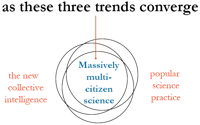
Massively multi-citizen science is almost here
Can a game developer be nominated for a Nobel Prize in one of the sciences by the year 2032? That's my plan, which I presented this past weekend at the annual meeting of the American Association for the Advancement of Science. You can download the slides from my talk, or read the related research paper (hot off the press!), or peruse some related links, on my AAAS webpage here. (Or see what Newsday took away from it here.)
My goal over the next decade is to support the development of a massively multi-citizen science through massively collaborative games (think: alternate reality games with real-world data embedded inside.) So in the near future, when the most creative, collective-intelligence gamers are grinding away 10, 20, 30, or more hours a week, they're grinding on real scientific research problems wrapped inside a yummy fictive or fantasy shell.
Yes, I am calling for a truly popular scientific research practice that engages the global public in hands-on, brains-on collaboration, via sites Citizen Science and Amazon's Mechanical Turk and through immersive, story-driven play. Amateur participation + a creative commons for science literature + the stickiness of a well-designed game and well-told story = radically interdisciplinary mash-ups accessible to lay people and productive of real scientific insight.
Sound crazy? No way. This is seriously possible, and plausible. Here's three reasons why:
1) Science practice itself is increasingly leaning toward a kind of collective intelligence, amateur participation. You can read about it in the incredible Institute for the Future report: Delta Scan: The Future of Science and Technology, 2005-2055.
2) Meanwhile, there is no doubt -- as I argue in my new 50-page case study for the MacArthur foundation -- that alternate reality gamers are doing real CI investigations that would fully prepare them for real-world collaborative research. Their gameplay is already fundamentally a CI scientific effort to undertand fake (fictive) data. I'm just proposing that we shove some real scientific data in there, while they're at it.
3) And perhaps most importantly, as Sean Stewart - the original and most esteemed alternate reality storyteller around - has famously said: "I do NOT assert that [alternate reality gaming] is the first, or greatest, example of massively multi-player collaborative investigation and problem solving. Science, as a social activity promoted by the Royal Society of Newton's day and persisting to this moment, has a long head start and a damn fine track record.... We just accidentally re-invented Science as pop culture entertainment."
So, yes, If this sounds interesting, get the slides. And here are a couple of other sites to get you thinking: "Fostering Scientific Habits of Mind in the Context of Online Play" and MacArthur Spotlight on Digital Media & Learning.
If you want to propose a data set, scientific problem, or research focus for a massively multi-citizen science game, or if you want to be notified when there's such a game to be played, email me at jane @ thenameofthisblog dot com. [bblogged by Jane on Avant Game]
Posted by jo at 06:00 PM | Comments (0)
February 08, 2007
2006 Alternate Reality Games White Paper

Performance Art
"[...] Beyond games and texts about games, performative art has sometimes used ARG strategies to break Brecht's "fourth wall." The traditions of performance art and guerrilla theater have, in retrospect, resembled ARGs in this way. This historical connection suggests a possible ideology for ARGs, in terms of performance art’s political and psychological activism. One may detect a trace of this in Jane McGonical’s account of ARG players wanting to participate in the war on terror11. Ray Johnson’s Zen-like practice of sending his art to galleries and correspondents is relevant here. As depicted in the biographical documentary How to Draw a Bunny (2002), Johnson’s mail art struck recipients as puzzles to be solved. The boundaries of each piece, like a good ARG puzzle, had to be determined in the course of exploration – what was a pun, what a bagatelle, what connected to which external referent?
Performative art can also intertwine an artist’s content with everyday life beyond either street theater or the gallery. For examples, Janet Cardiff has developed her Walks series since 1991. The audience experiences sounds through portable recorders as they walk through locations, the contents of which are largely or entirely native, rather than created as part of the project. As the description of a 2005 instance reads, Cardiff creates augmented realities: interactive works where visitors are asked to touch, listen and move through environments layered with visual and aural narratives. At a less avant-garde level, historical reenactments resemble both ARGs and performance art. Their encampments, fairs, spectacles are not as intrusive to outsiders as performance art can be, since they are formally and clearly demarcated. But the plunging down a rabbit hole of ARG play, the sense of immersion into a world extending very far beyond one’s ability to encompass, is a key part of the reenactor experience. Summoning up a historical moment, be it the seventh century, the American Civil War, or Jane Austen’s time, literally creates an alternate reality within our own..." Read 2006 Alternate Reality Games White Paper [PDF]. [via]
Posted by jo at 06:53 PM | Comments (0)
September 15, 2006
Gaming Realities

Virtual Spaces are the New Public Spaces
In less than a month Gaming Realities, one of the biggest festivals to date encompassing the critical exploration of videogames in the fine arts and humanties, kicks off in Athens. The festival hosts a great line up of artists and speakers, many of which we've covered or archived here at Selectparks over the years (Blast Theory, Sir Frasca, Darwinia, Eastwood Group, Molleindustria and many more). I'll be there, so if you're at the festival come to my keynote and ask some impossibly difficult questions when I least expect it. Cheers! Read on for the comprehensive press release and exhbition details. [posted by julian on selectparks]
EXHIBITION: NetODrom by Christoph Anthes, Alexander Wilhelm, Helmut Bressler, Roland Landershamer, Johannes Zarl, Silke Wiesinger; Austria, 2005 :: Can you see me now? by Blast Theory; U.K., 2001 :: Philosopher Death Match by Benjamin Chang; U.S.A., 2006 :: Grid Chase - The 5€ Dance Pad Project by Dimi Christopoulos; Greece, 2002-2006 :: Himalaya’s Head by DEVART; Netherlands, 2005 :: Civilization IV – Age of Empire by Eastwood Group; Serbia, 2004 :: N o w h e r e - ein welt raum spiel by Sylvia Eckermann, Gerald Nestler, Christof Cargnelli, Oliver Irschitz; Austria, 2005 :: Bordergames by Fiambrera; Spain, 2005 :: Postvinyl by Mathias Fuchs; U.K., 2005 :: Lykno by David Gauthier, Henri Marino, Laurie Prevot, Jean Batiste Spieser; France, 2006 :: Semiomorph by Troy Innocent; Australia, 2001 :: Darwinia Introversion Software, U.K., 2005 :: Ready Played by The Ludic Society (Margarete Jahrmann/Max Moswitzer); Austria/Switzerland, 2006 :: Kalamiotou_02 by The mamayans; Greece, 2006 ::
Max Payne cheats only by Jodi; Netherlands :: Ariadne’s Sonic Threadball by Panagiotis Koutlemanis, Dimitris Dinieas; Greece, 2006 :: Façade by Michael Mateas, Andrew Stern; U.S.A., 2005 :: The McDonalds’s Videogame by Molleindustria; Italy, 2006 :: Soviet Unterzogersdorf the adventure game by Monochrom; Austria, 2005 :: Book and Volume by Nick Montfort; U.S.A., 2005 :: The making of Balkan wars: the game by Personal Cinema; Greece, 2004 :: Disaffected by Persuasive Games; U.S.A., 2006 :: Interactive Circus by Prof. Marie-Helene Tramus, Cedric Plessier; France, 2005 :: Jumping Rope by Orna Portugaly, Daphna Talithman, Sharon Younger; Israel, 2004 :: Global Conflicts: Palestine by Serious Games Interactive; Denmark, 2005-2006 :: Boys in the Hood by Axel Stockburger; Austria/U.K., 2005 :: The endless forest by Tale of Tales; Belgium, 2005 :: Game Music by Vladimir Todorovic; Serbia, 2004-2005 :: Fijuu2 by Julian Oliver, Steven Pickles; Germany - New Zealand, 2006 :: Coin Snatch by sheismartha, Alexandros Plakidas Dasios; Greece, 2006 :: History Lost Redux by University of the Aegean; Greece, 2006 ::
Conference Highlight:
The democratisation of virtual environments
Personal Cinema
International New Media Collective
A spectre is haunting Virtual Environments, their democratisation.
It is the spectre of democracy, which after the abandonment of its physical space [real life] sinking more and more in the contradiction of lies and the cancellations that lead to its constitution, it breached the relations with the real and it became itself a spectre. This is how the paradox of spectre occurred, the wandering shadow of democracy. A spectre that tries to penetrate, and aims to democratise the new kind of ghosts that constitute the space which forms a major element of human experience: The Virtual Environments.
The democratisation of virtual environments, computer and video games is one main debate issue in the industry of interactive media. In new media and especially video games the democratisation is related mainly to the fact that the user, in the context of interaction and personalisation, takes major part in the creation process of the games themselves. Mods, thousands of volunteer designers in Half Life, Everquest, Oblivion, and Quake, are examples of how the users participate in the creation process. If we are able to discuss something new in new media it is the user’s capability to participate in the creation process. This capability is not a gift or an offer of a generous democratic technology, but immanence within its own structure, it is an immediate reflection of the conflicts that constitute this capability of participation which has as its final destination democracy.
In other words, speaking of the conditions which arose from the utopian meeting of spectres, which magical ritual could be useful for both the old spectre of democracy and the ‘spectral’ world of virtual environments?
The vast majority of the users understand democracy according to the quantity of interactive “clicks” which represent the voting “right” in cyber space. The image of the voting procedure and democratisation in virtual space isn’t the supposed infinite choice of different web pages or the user’s ability to create personalised narration in a video game; it is the image of the cursor itself over the icon of “choice” accompanied by the sound of the “click” which really is the extension of the image of the poll and the hand that is “capable of choosing”.
How is possible to revive democracy in the realm of the potential, when within the context of the objective it became a commodity that has usually been exported and imported via violence?
Posted by jo at 09:32 AM | Comments (0)
May 08, 2006
Troy

Alternate Reality Game
"One of the shared characteristics of all the types of game is to be closed systems, limited in time and space, as a sort of 'magic circles' where the player voluntarily decides to enter. Troy is a small but brilliant example of an 'alternate reality game', or a game that uses different media and disregards any formalized rule deliberately trying to wandering off the ludic universe. The game has been created on the occasion of the Experimental Gameplay Competition, themed on 'violation', and it has suddenly threw the publishing portal into turmoil.
The link recommended by the author pointed to a 'file not found' page. Only the most curious users has clicked on the almost standard 'parent directory' link. Doing so the user can see the spartan directory tree, typically listing all the files in the remote folders that have no index file. At first glance it seems a hitch, one of the many interface errors that can be seen during the netsurfing practice, but actually it's the proper game start. The surfer / player can snoop around the Troy's author personal files, collecting information about him, in order to access restricted areas and to search for the elusive videogame, built for the competition.
The player will know about a recent breaking-off of the author's engagement, that will be the key to get an important password. It's a proper meta-game that thematizes the privacy violation on the net, stimulating the player digital voyeurism. It's a tough game, indeed, and it has also a distinct geek taste because of the riddles complexity. Anyway the solution (written by the author, the 'original' one) can be finally found here." -- Paolo Pedercini, NEURAL.
Posted by jo at 12:46 PM | Comments (0)
April 25, 2006
Joi Ito
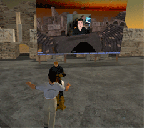
Recursive video in Second Life
Had our first meeting inside of Second Life today to talk about the island. Thanks to everyone who showed up. Special thanks to Aimee Weber who donated an amphitheater! She showed me how to play videos inside of Second Life. So... I tried making a very recursive video of me watching a video of me watching a test video of myself. Watching a video together inside of Second Life actually works well. The audio and video quality is excellent and you can chat about the video and other things while you watch. It's really neat sharing a space like this together...
I uploaded a video iPod format m4v and a AVI format of the movie. Too bad the audio doesn't work... or for your sake, maybe it's better that it didn't. [via Joi's blog]
Related: 
Virtual Lives
"...Business Week (via Terranova) has a podcast, two slideshows and a story about Second Life and other MMORLG, money and advertising. Good wrap-up if you're interested in the topic but don't have the time to follow it closely (check also The Future of Credit Cards - Earning virtual currency for spending in the real world & other world bridging, by Phillip Torrone.)
Anshe Chung - the "virtual Trump" - even gets the cover of the mag. The land development business, which the avatar has built from nothing two years ago, has turned into an operation of 17 people. Second Life participants pay Linden dollars, the game's currency, to rent or buy virtual homesteads from Chung so they have a place to build and show off their creations. They can then convert the play money into dollars by using their credit card at online currency exchanges. To handle rampant growth, Chung opened a 10-person studio and office in Wuhan, China. Says Chung's owner: "This virtual role-playing economy is so strong that it now has to import skill and services from the real-world economy."..." [from Regine's post on we-make-money-not-art]
Posted by jo at 09:06 AM | Comments (0)
February 22, 2006
Wearable Game

Clues Woven Into Cloth
If you find yourself wearing clothes from a new company called Edoc Laundry, beware: Strangers may walk up to you on the street to examine the intricacies of your shirt's patterns. That's because Edoc Laundry's first line, expected to launch March 1, literally weaves an episodic, multimedia game into the fabric of the garments. The Seattle-based company is believed to be the first to attempt such a fashion feat.
The idea is an extension of so-called alternate-reality games, or ARGs, in which people try to solve puzzles that are propagated online but require players to team up to find clues in the real world. Usually, the games are promotional vehicles for other products, including video games and movies. Examples of ARGs include 2004's "I Love Bees," which was a lead-in to Bungie Studios' "Halo 2" for Xbox, and 2005's "Last Call Poker," which promoted Activision's "Gun."
Edoc Laundry's line integrates an ARG into its shirts, hats and accessories. The story involves the mysterious death of the manager of a fictional band called Poor Richard. Players find clues such as words and symbols embedded in the clothes. They then head to a Web site where they can unlock complex elements of the overriding story of Poor Richard and its music..." Continue reading Wearable game weaves clues into cloth by Daniel Terdiman, CNET News.com. [via Jim Downing on Smart Mobs]
Posted by jo at 07:33 PM | Comments (0)
February 01, 2006
Perplex city
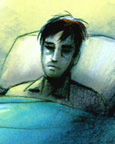
the first self-supporting ARG
Guy says: "Perplex City is a cross between collectible-card game and Alternate Reality Game. It's centered around a stolen artefact, and there's a $200,000 reward for whoever can find it. The cards themselves are rather beautiful and feature a diverse range of mind-bending puzzles, while Anton Bogaty (who you just featured) does much of the artwork for the game. I think it's primarily worth mentioning because it's the first self-supporting ARG, as opposed to marketing something else (or being made on a lo-to-no budget basis.) "Also, Boing Boing itself is on one of the cards!
"There are also some live events coming up in New York and London, making it especially news-worthy right now - anyone can participate, as they aren't especially about PXC, just friendly puzzlin' competitions. Although the London event is closed to sign-ups, after 600 people applied..." (Here is Guy's quick-start guide to the game.) [posted by Mark Frauenfelder on Boing Boing]
Posted by jo at 10:04 AM | Comments (0)
November 03, 2005
Jane McGonigal
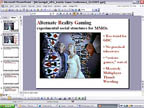
ARG Slides and Graveyard Games, NYC
Jane McGonigal recently gave a design-track lecture called Alternate Reality Gaming: Experimental Social Structures for MMOs at the Austin Game Conference. "The unofficial title of the talk was "Too weird for GDC." Also, the culmination of the talk was a lively 100-person game of massively multiplayer thumb wrestling. The slides are now posted here." [Related]
On Saturday November 5, 2005, Jane's Graveyard Games will be in New York City so you can meet the living and play with the dead. You're invited rain or shine to Brooklyn’s own Cypress Hills Cemetery to get to know your local dearly departed, pay your respects, and learn Tombstone Hold 'Em — the secret poker game you can only play in a cemetery.
Posted by jo at 10:13 AM | Comments (0)
November 02, 2005
idades

Virtual Ball Game
idades--by Antonio Urquijo de Simón, Carolina Padilla Villarraga, Daniel Desiderio Páez Castillo, Jordi Puig Vilà and Philip Morris--is a communication network of installations placed in transit spaces. In each of them, a spectator can recognize his or her simulated silhouette projected onto a screen and discover that his or her movements effect the trajectory of a virtual ball that bounces as it touches the edges of the silhouette. This triggers a game played by the body of the spectator, along with other passersby who enter the visual field of the camera.
The ball acts as an "interconnection device" which, as it collides virtually with the body of the players, promotes in them a corporal response to keep it in movement. The installation includes a camera used as a sensor, a computer connected to the camera that cuts the image of the people, a projector that displays the game, situated behind the interaction zone, and a screen, displayed in such a way as to ensure the normal circulation of people. Showing at the FILE Festival in São Paulo, through November 20, 2006. [blogged by Regine on we-make-money-not]
Posted by jo at 11:46 AM | Comments (0)
October 14, 2005
Real-life video games

Faux Kidnappings
Artist Brock Enright is notorious in the US as the man who performs "bespoke executive kidnappings" for $1,500 a time. Every abduction is tailored to the phobias of each "victim" to offer "maximum terror". Enright's activities reach beyond acts of abduction, his Video and Adventure Services company to offer tailormade products that shamelessly explore personal perversions.
While kidnapping dominates perceptions of his company, VAS offers a host of "customised reality adventures", or real-life video games. "Some people are lonely and want to make friends," says Enright. Some people want to be stalked, others want "to feel like they're slowly going crazy". After drawing up legal contracts detailing what they can and can't get away with, VAS bring these fantasies to life, with the help of actors and locations. His Raising Dead Mothers show is at the Vilma Gold gallery, London E2, until October 16. [The Guardian].
Reminded me of Kidnap. In 1998 Blast Theory launched a lottery in which the winners had the chance to be kidnapped. Ten finalists were chosen at random and put under surveillance. Two winners were then snatched and taken to a secret location where they were held for 48 hours. The whole process was broadcast live onto the internet. Online visitors were able to control the video camera inside the safehouse and communicate live with the kidnappers. During the run up to Kidnap, a 45 second video - the Kidnap Blipvert - was shown at cinemas around the UK. The Blipvert carried a freephone number, allowing people to register their interest. [blogged by Regine on we-make-money-not]
Posted by jo at 12:52 PM | Comments (0)
September 27, 2005
Lineage II

Computer Characters Mugged in Virtual Crime Spree
"A man has been arrested in Japan on suspicion of carrying out a virtual mugging spree by using software "bots" to beat up and rob characters in the online computer game Lineage II. The stolen virtual possessions were then exchanged for real cash.
The Chinese exchange student was arrested by police in Kagawa prefecture, southern Japan, the Mainichi Daily News reports.
Several players had their characters beaten and robbed of valuable virtual objects, which could have included the Earring of Wisdom or the Shield of Nightmare. The items were then fenced through a Japanese auction website, according to NCsoft, which makes Lineage II. The assailant was a character controlled by a software bot, rather than a human player, making it unbeatable.
Ren Reynolds, a UK-based computer games consultant and an editor of the gaming research site Terra Nova, says the case highlights the problem of bots in virtual worlds.
Arms race
By performing tasks within a game repetitively or very quickly, bots can easily outplay human-controlled characters, giving unscrupulous players an unfair advantage. Many games firms employ countermeasures to detect this bot activity. For example, they can ask the character questions or present them with an unfamiliar situation and monitor their response.
"There's an ongoing war between people who make bots and games companies," he told New Scientist. "And making real money out of virtual worlds is getting bigger."
Furthermore, the line between virtual and real cash has already disappeared. The game EverQuest, for example, lets players buy and sell virtual items and characters for real money through an authorised online trading site.
Money breeds crime
Reynolds says the growing number of online game players will only increase the incentive for scammers. "There's nothing exceptional about the virtual world," he says. "Wherever there is that sort of money, there's always crime too."
Bruce Schneier, a renowned computer security expert, adds that the distinction between virtual and real crime is rapidly disappearing. He points to recent reports of crooks trying to hack into games or steal players account information to make cash.
"I regularly say that every form of theft and fraud in the real world will eventually be duplicated in cyberspace," Schneier wrote on his weblog. "Perhaps every method of stealing real money will eventually be used to steal imaginary money, too."
There are also reports that some online scammers are using “sweatshops” in countries such as China and Indonesia in which people monitor teams of bots in order to generate money whilst avoiding bot traps."
Will Knight, NewScientist.com [via]
Posted by jo at 12:05 PM | Comments (0)
September 19, 2005
The Hunt for Mr. X:

Bringing a Board Game to the Street
"Scotland Yard" is a popular board game in Europe, where players have to catch Mr. X. Mr. X moves hidden through the streets of London. He has to show his location every 4th turn. The detectives know which kind of transportation he uses. With this information they have to figure out his position and surround him. When the detectives catch him, they win, if Mr. X escapes he wins.
Bringing the game to the street: transformation into a live action game 4 groups with 4 players hunt Mr. X and Mr. Y in the old city of Berne. Hunting by MMS: Every ten minutes, Mr. X sends a picture of his current location. The detectives have to identify the position by the pictures and find Mr. X. They catch Mr. X by taking a picture of him." From "The Hunt for Mr. X: Bringing a Board Game to the Street [PPT] by Niklaus Moor (Swisscom Innovations). [via techkwondo] [Related]
Posted by jo at 11:51 AM | Comments (0)
August 24, 2005
Career Moves
Players Can Create Their Own Semantic Systems
Career Moves--by Mary Flanagan--explores the contradictory world of women in corporate America through an interactive, computer controlled board game. Work is a troubling condition internationally for all women. Women represent 50 per cent of the world adult population and one-third of the official labour force, but they perform nearly two-thirds of all work hours, receive one-tenth of the world income and own less than 1 per cent of the world's property...
This commercial style is intended as a critique of the historical sequence to which the popular board game belongs: many games have traditionally supported social "norms," including heterosexuality, consumerism, and especially non-liberatory positions for women. However, as players progress down the board, it becomes clear that it is they themselves who are determining the rules of the game, and the collective and individual goals become apparent...
To participate in Day of the Figurines, the player must first visit a physical place. Here, they find a large scale model of an imaginary town at table height. The model is 1:100 and extends for several metres in all directions. The image is a mix of computer graphics and photographic collage.
The town has identifiable buildings such as the YMCA, the Big Chef, Video Zone, the XXX Cinema and the Battle of Trafalgar Square. There are other features such as a Cemetery, a Gasometer, a canal, a Level Crossing and an Underpass.
To play the game the visitor selects from a display of one hundred plastic figurines. They give the figurine a name, answer a few questions about him or her and then watch as she or he is placed at a random location into the model town. As they leave the space the player is given a small map of the town and a set of rules for the game.
An hour or so later the player will receive their first text message from the game, asking where their figurine would like to go. By replying to the message with the name of a place in the town the player’s figurine is set on the path towards that destination. Each hour a turn is executed and the invigilator moves each figure a small distance towards their destination. There are 10 turns a day for 24 days.
Intermittently each player receives text messages to alert them to nearby figurines in the model city, to their figurine’s arrival at a destination or to other events in the town. Each destination has a short description. For example, if you arrive at the The One Club you receive the SMS: “Home of the 2 Fs. The lock ins are legendary, the fire escape stairs have seen it all.” The goal of the game is “to help others”. Texting messages to other players may provide opportunities to do this.
The project is deliberately targeting low-end phones: it is playable on any phone that is able to receive SMS. Instead the technological focus is on orchestration and management tools. During the long-term test period, 8 players have been given phones that log Cell ID and upload this information to a server. We aim to use this data to assess when players are engaged, when they are most likely to play and how the game fits into their daily activity pattern. We will also carry out phone interviews with selected players at key moments, to study the interaction between game play and daily life.
Posted by jo at 10:12 AM | Comments (0)
May 30, 2005
floating eye

mission: engage playful imagination
Jenny Marketou's Flying Spy Potato mission-based reality game sends the player into a demarcated section of the urban environment with a tethered weather balloon equipped with a networked cam that transmits wirelessly via radio receiver back to the gallery where the video from the floating cam is both logged and projected.
The game objective is for each player to complete their mission which contributes toward the collective capturing of the game board.
Posted by michelle at 05:05 PM | Comments (0)
May 25, 2005
Alternative Realities in Networked Environments
A Comprehensive Medium for Exploring Emotions
The Alternative Realities in Networked Environments [ALTERNE] working group has completed the project and the results are being transferred to a new web site. The ALTERNE project objective was to construct an Alternative Reality platform to support the development of digital, interactive and participatory artistic activities. We define Alternative Reality as a generalization of Virtual and Mixed Realities beyond the common "space-based" simulation. The aim of the technical development is to extend the current techniques of Mixed Reality to support the more advanced experimentation with reality and virtuality that are required by the process of artistic creation. While traditional Virtual Reality essentially addresses the construction of visually realistic synthetic worlds, ALTERNE supports additional layers that will make it possible to explore other concepts such as: causality, relations between time and space, alternative laws of physics, alternative life forms, etc., in a more radical fashion.
ALTERNE platform brings a high level of integration between the current techniques supporting Mixed Reality, graphics, interaction and behavioural models. It promotes the artistic development and explorations of various forms of perception of spatiotemporal orders by placing the human body and its digital surrogates at the centre of the aesthetic considerations. One example is to provide a more comprehensive medium for the exploration of emotions, from the movements of the human body to the socialized interpretations of action.
Certain tools developed by ALTERNE will be made available over its web site and the MARCEL site as well. Some network tools are already posted for downloading.
Information Society Technologies: ALTERNE is a multi-annual research and development project supported by European Commission within Cross Programme Action 15 (Technology Platforms for Cultural & Arts Creative Expressions) of DG Information Society (reference nr. IST-2001-38575).
Posted by jo at 12:16 PM | Comments (0)
March 25, 2005
Pervasive Game Development Today

24/7 Immersion
"...Pervasive gaming was first the vision of Swedish company It's Alive!, meaning location-based games that surround you, 24 hours a day, everywhere. When you walk down the street, you're walking through an adventure world draped on top of the real world, and people you meet may be characters in the same game you're playing. Pervasive games are built upon three core technologies: mobile devices, wireless communication, and sensing technologies that capture players’ contexts. It is actually the blend of technologies combined with the location-based and often public nature of game play, gives pervasive games their distinctive identity [Bridging the Physical and Digital in Pervasive Gaming]." From Pervasive Game Development Today by Fabien Girardin.
Posted by jo at 02:10 PM | Comments (0)
The Matrix Online

Actors Hired to Live In-World
"This is amazing news: The Matrix Online is employing 20 'actors' - live humans - to live in-world, interact with players and create storylines.
Since the close of the beta, Warner Bros. Interactive Entertainment announced that it has employed a troupe of 20-odd people whose job it will be to enact narrative scenarios in The Matrix Online live. These people will assume the roles of popular characters, interact with players, and generally move the stories in ways that only live "actors" can. And though it appears that the story hasn't officially commenced, a few players on the Method server were treated to a pretty slick sample of it this afternoon: an extended pep-talk by none other than Morpheus himself." [via Wonderland]
Posted by jo at 02:02 PM | Comments (0)
February 28, 2005
Vivienne

Virtual Girlfriend
"The International Herald Tribune writes about Vivienne, the new 3G girlfriend created by Artificial Life, a software house in Hong Kong. It'a a virtual application with a computerized synthetic voice who likes to receive flowers and chocolates, translates six languages and can converse on 35,000 topics. The service is already available in Malaysia and Singapore, and will arrive in Europe later this spring.
At the moment V-Girl is basically considered a game (it won the global Best Mobile Game Award by Ericsson). Apart from this use for lonely hearts, the application developed by Artificial Life might become very interesting, especially for companies that want to enhance the management of the relationship with their customers." [blogged on making money out of mobile]
Posted by jo at 09:27 AM | Comments (0)
February 18, 2005
Search Opera

Social Collaboration as Collective Performance
MSN has launched a stealth "search opera" to help promote their new search engine. According to Sean Stewart (author behind the Alternate Reality Games The Beast and I Love Bees): "...a search opera is a story treated as a scavenger hunt and a jigsaw puzzle rolled into one. What's particularly nice about the search opera is that for a decade now people have been looking for a way to use the internet as an artistic medium. The net wants to be interactive, and it wants to be social. A search opera allows a collective audience to have an artistic experience while searching and gossiping and decoding and speculating: in short, while doing the things that the net was really born to do."
The MSN Search Opera (ARG) centers around a guy named Cy and his conspiracy website. Following the links on Cy's site and clues garnered by entering specific keywords into the MSN search engine yields videos (some of which are pretty funny), more characters, their journals, and a story that will develop over upcoming weeks.
reblogged from Alternate Reality Gaming Network
Posted by michelle at 08:31 PM | Comments (0)


